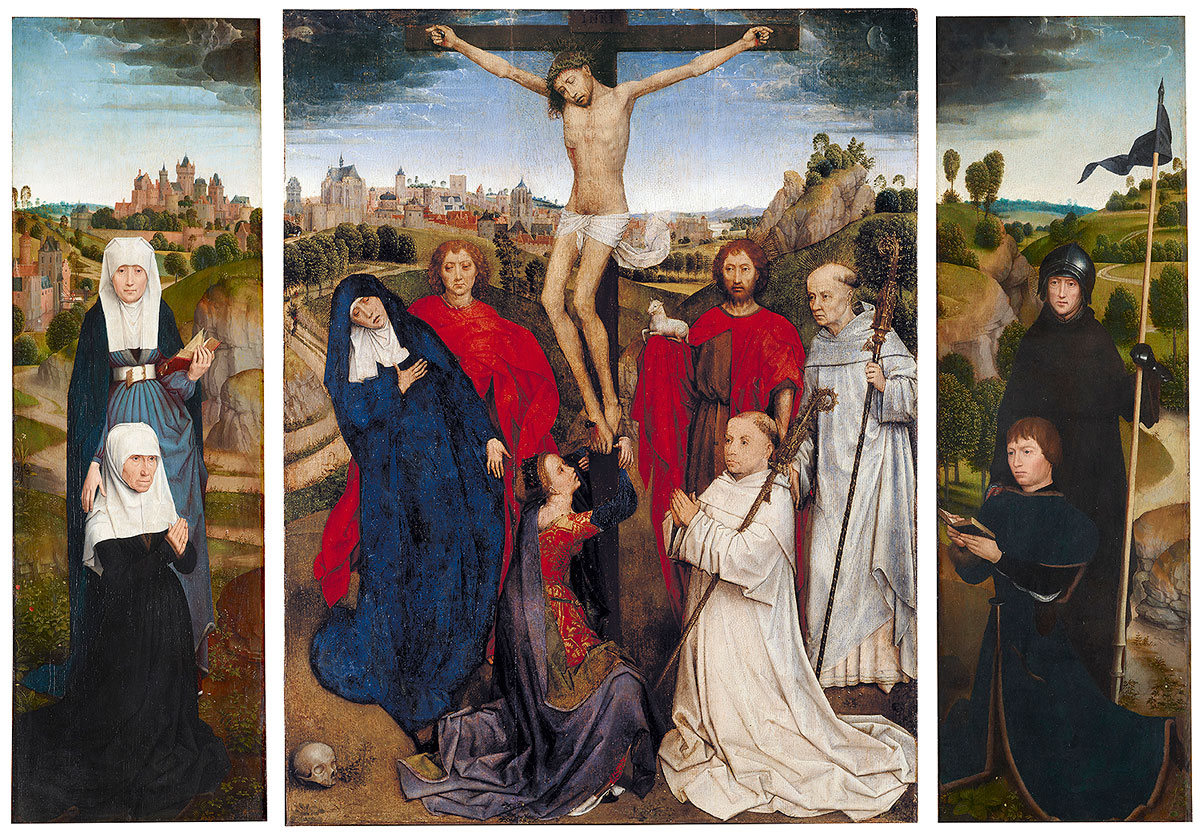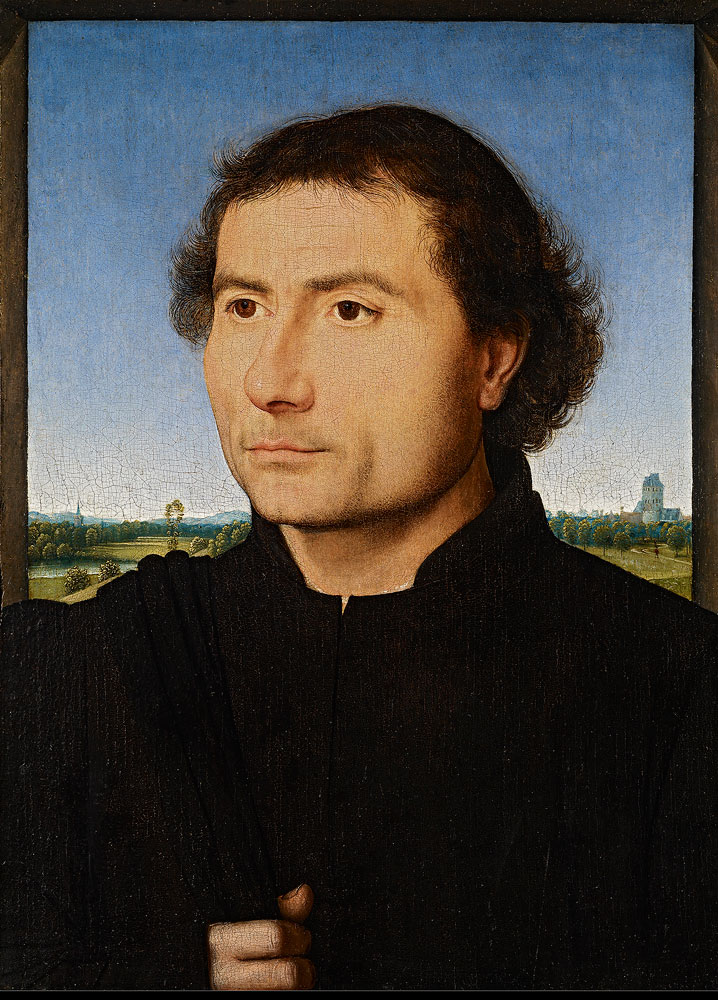Hans Memling: Portraiture, Piety, and a Reunited Altarpiece
September 2, 2016 through January 8, 2017
Completed around 1470 in Bruges, Hans Memling’s extraordinary Triptych of Jan Crabbe was dismantled centuries ago and the parts were scattered. The inner wings from the altarpiece are among the finest paintings owned by the Morgan Library & Museum, where they have long been on permanent view in museum founder Pierpont Morgan’s study.
Hans Memling: Portraiture, Piety, and a Reunited Altarpiece , opening on September 2, reunites the Morgan panels with t he other elements of the famous triptych: the central panel from the Musei Civici in Vicenza, Italy, and the outer wings from the Groeningemuseum in Bruges, Belgium.
The Triptych of Jan Crabbe , ca. 1467-70. Oil on panel. Cent er panel: Image courtesy of Pinacoteca Civica di Palazzo Chiericati, Vicenza. Left and righ t panels: © The Morgan Library & Museum, Photography by Graham S. Haber.
This exhibition—on view through January 8, 2017—is the first to explore the reconstructed masterpiece in context. The altarpiece will be su rrounded by other paintings by Memling and his contemporaries, by a choice selection of illumi nated manuscripts from Bruges, and by a group of Early Netherlandish drawings.
Aside from the t iptych fragments from Italy and Belgium, loans from the Metropolitan Museum of Art, the Fr ick Collection, and a private collection will complement a range of works fr om the Morgan’s own holdings.
The Crabbe triptych is a masterpiece of the first order and shows a relatively young Memli ng demonstrating many of the characteristic elements of his work—crystalline realism, spatial sophistication, and the ability to capture the humanity and individuality of his subjects.
THE EXHIBITION
Triptych of Jan Crabbe
Morgan acquired the triptych’s inner wings in 1907. They were part of an altarpiece commissioned by Jan Crabbe, Abbot of the Cistercian monastery of Ten Duinen, near Bruges, Belgium. On the central panel, Memling depicted the crucifixion of Christ, with the Virgin Mary, St. John the Evangelist, and St. Mary Magdalene to the left of the cross. Kneeling to the right of the cross is Jan Crabbe, accompanied by his name-saint St. John the Baptist and St. Bernard of Clairvaux, the founder of the Cistercian order. The two inner wings depict members of the patron’s family: his mother Anna Willemzoon with St. Anne on the left, and his much younger half-brother Willem de Winter with St. William on the right. The outer wings, originally visible only when the panels are closed, feature an Annunciation scene with the Angel Gabriel and the Virgin Mary. It is not known precisely when or why the work was dismantled, though it was not unus ual for composite pieces such as triptychs to suffer this fate.
The Triptych of Jan Crabbe is a fine demonstration of Memling’s extraordinary ability to capture the essence of the human face. In particular, the left panel portrait of Anna Willemzoon is one of the most frank and extraordinary depictions of old age from the Renaissance. Indeed, in later years, Memling’s portraiture wo uld come to revolutionize the genre across Europe. Similarly transformative, the Annunciation scene features Gabriel and the Virgin Mary clad in white drapery and set on pedestals in niches like sculptures, but with rosy flesh tones in their heads and hands, making them one of the earliest examples of the technique of demi-grisaille in Flemish painting.
Triptych of Jan Crabbe in Context
Paintings by Memling and his Contemporaries
Several independent portrait paintings from Memling’s early and late career offer further evidence of Memling’s extraordinary talent as a portraitist. Although Memling’s painterly style developed as he grew older, his ability to capture the essenc e of his sitters’ personalities never changed. Memling did not work in isolation, and a painting representing the Virgin and Child with St. Anne by a contemporary artist known as the Master of the Saint Ursula Legend provides an ideal counterpart to the triptych with its broad landscape and similar iconography. It shows how Memling’s production fits alongside that of other painters in Bruges, while also highlighting how his technical abilities surpassed most others.
Manuscript Illumination in Bruges
n the fifteenth century, Bruges was an important center for manuscript illumination. Mem ling’s development of the demi-grisaille technique has generally been traced to his time spent in Cologne, but in fact, varieties of grisaille and demi-grisaille were regularly used in Bruges manuscript illumination in the decades prior to the painting of the Crabbe triptych, as will be shown with a selection of Books of Hours from the Morgan’s rich holdings. Conversely, the radical naturalism of Memling’s painting seems to have served as an inspiration to the manuscript painters. Superb manuscripts from the Morgan’s collection will show that reflections of Memling’s painting technique began to appear in manuscript painting towards the end of the fifteenth century.
Hans Memling (Flemish, ca. 1440–1494), Portrait of a Man , ca. 1470, Oil on panel. © The Frick Collection.
Master of the Saint Ursula Legend (Flemish, active late 15 th century), Virgin and Child with St. Anne presenting Anna van Nieuwenhove , ca. 1479-83. Oil on panel. © Metropolitan Museum of Art, Robert Lehman Collection.


